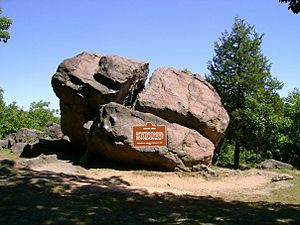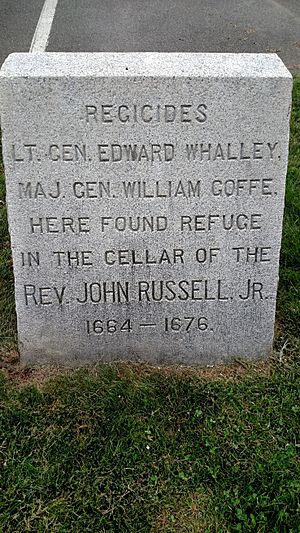Edward Whalley facts for kids
Quick facts for kids
Edward Whalley
|
|
|---|---|
| Born | c. 1607 England |
| Died | c. 1675 Hadley, Massachusetts Bay Colony |
| Allegiance | England |
| Service/ |
Army |
| Rank | Lieutenant-General |
| Battles/wars | English Civil War |
| Signature | |
Edward Whalley (born around 1607 – died around 1675) was an English military leader. He played a big part in the English Civil War. He was also one of the people who signed the paper to execute King Charles I of England.
Contents
Edward Whalley's Early Life and Career
We don't know the exact dates of Edward Whalley's birth or death. He was the second son of Richard Whalley. His father was a important official in Nottinghamshire in 1595. Edward's mother, Frances Cromwell, was the aunt of Oliver Cromwell. Oliver Cromwell later became a very powerful leader in England.
Edward Whalley might have started as a woollen-draper, someone who sells cloth. In the 1620s and 1630s, he tried farming in Chadwell St. Mary, Essex. But this farming business didn't do well. In 1639, Whalley had to leave for Scotland to avoid people he owed money to. He left his wife behind.
When the English Civil War began, he joined the Parliament's army. He became a cornet, a low-ranking officer, in a cavalry troop. He fought in the Battle of Edgehill. Later, he became a major in Oliver Cromwell's cavalry regiment. He was a brave soldier. Cromwell especially praised him for his actions at Gainsborough in 1643. He also fought at the Battle of Marston Moor. He led one of Cromwell's cavalry regiments at the Battle of Naseby. He also helped capture Bristol. He was then sent to Oxfordshire and took Banbury. He was attacking Worcester when he was replaced. This happened because of his strong religious beliefs.
A Key Officer in the Army
In 1647, Edward Whalley supported his regiment. They had complaints against the Parliament. When the army captured King Charles I, Whalley and his regiment were in charge of guarding him at Hampton Court Palace. Whalley treated the King with respect. He even refused to remove the King's chaplains (religious advisors). King Charles later sent him a letter to thank him.
During the Second English Civil War, Whalley again showed his skills as a soldier. He was chosen to be a judge at the trial of King Charles I. He was the fourth person to sign the King's death warrant, right after Oliver Cromwell. The King was executed in London on January 30, 1649.
In April 1649, some soldiers in his regiment took part in a protest. It was called the Bishopsgate Mutiny. They refused to go on a trip to Ireland. They wanted their political demands met and to be paid money they were owed. They were told to leave London. When they refused, fifteen soldiers were arrested. Six of them were sentenced to death. Five were later forgiven, but one soldier, Robert Lockyer, was shot.
Whalley joined Cromwell's trip to Scotland. He was hurt at the Battle of Dunbar. In late 1650, he worked to solve problems in the north. The next year, he helped Cromwell chase Charles II. He fought in the Battle of Worcester.
He supported Cromwell throughout his political career. He presented the army's requests to Parliament in August 1652. He approved of the "protectorate," which was Cromwell's government. He represented Nottinghamshire in Parliament in 1654 and 1656. He also helped in the case against a Quaker named James Naylor. He was one of the "major-generals" who governed different parts of England. He was in charge of Lincoln, Nottingham, Derby, Warwick, and Leicester. He supported a plan called the "Petition and Advice." But he did not agree with Cromwell becoming king. In December 1657, he became a member of the new House of Lords.
When Oliver Cromwell died, Whalley was there. He tried to support Cromwell's son, Richard Cromwell, as the new leader. But his regiment refused to follow his orders. The Parliament removed him from his army command. In November 1659, he went on a trip to Scotland. He tried to make an agreement with George Monck, but it didn't work.
Hiding in the American Colonies
When the King returned to power in England, called the Restoration, Whalley had to escape. He went to North America with his son-in-law, Major-General William Goffe. They arrived in Boston on July 27, 1660. People there welcomed them, including Governor John Endecott. They lived openly in Cambridge, about 2 miles (3.2 km) from Boston.
At this time, the English Parliament was deciding who would be pardoned (forgiven) for their actions during the war. News reached the colony that most of the people who signed the King's death warrant would be pardoned. But seven would not. The colony didn't know the final list until November 1660. For several months, leaders in the colony disagreed about what to do with Whalley and Goffe.
By February 1661, the Governor seemed to change his mind. On February 22, he called a meeting to discuss arresting them. But the court did not agree. Whalley and Goffe decided they were no longer safe in Cambridge. They left on February 26. A few days later, on March 8, orders arrived from England to arrest them. Daniel Fisher and his sister Lydia helped them hide.
The two men moved to New Haven, Connecticut. Another person who signed the King's death warrant, John Dixwell, was living there under a different name. Whalley and Goffe arrived on March 7, 1661. They stayed with John Davenport, the local minister. When news of the arrest orders reached New Haven, Whalley and Goffe tried to trick anyone looking for them. They pretended to leave for Milford and made sure they were seen there. But that night, they secretly returned to New Haven. They secretly stayed with Davenport and other friends until May 13. Then, they hid in some woods and a cave on Providence Hill. This hill is now called West Rock, and the cave is known as Judges Cave.
In August, they moved into a house in Milford owned by a friend, Mr. Tomkins. They stayed there for two years. In 1664, they had to return to the cave when the King's officials arrived in Boston. But Native Americans found the cave when the two were not there. This forced them to move further away from Boston. On October 13, they traveled only at night. They went to Hadley, about one hundred miles north in western Massachusetts. The minister there, John Russell, had arranged for them to live with him. They stayed hidden there for fifteen or sixteen years. Their wives in England sent them money. A few supporters who knew where they were also sent gifts. This helped them pay their host. For the first few years, they were always afraid of being found. They were very relieved to read in newspapers that people thought they had died in Switzerland. The English government tried many times to arrest Whalley or Goffe, but they always failed. Whalley was alive but not well in 1674. He probably died not long after that.
Edward Whalley's Family
Edward Whalley first married Judith Duffell (or Duffield) on February 7, 1626. They married at St. Dunstan's Church in Stepney. Judith was from Rochester, Kent. They had several children, including a son named John and a daughter named Frances. Frances later married William Goffe, who was also one of the people who signed the King's death warrant.
Edward's second marriage was to Mary Middleton. She was the sister of Sir George Middleton. Edward and Mary had two sons, Henry and Edward.
Legacy of Edward Whalley
Edward Whalley is remembered in New Haven, Connecticut. A street there is named after him: Whalley Avenue. The other two people who hid in New Haven, Dixwell and Goffe, also have streets named after them. These streets meet at the northwest end of Broadway.
Hadley also has two parallel streets named after Goffe and Whalley. There is also a memorial stone where John Russell's home used to be. This stone remembers where Whalley and Goffe hid.
Edward Whalley in Popular Culture
Edward Whalley and William Goffe are the main characters in a 2022 novel. It's called Act of Oblivion by British author Robert Harris. The book tells the story of their escape across New England.



